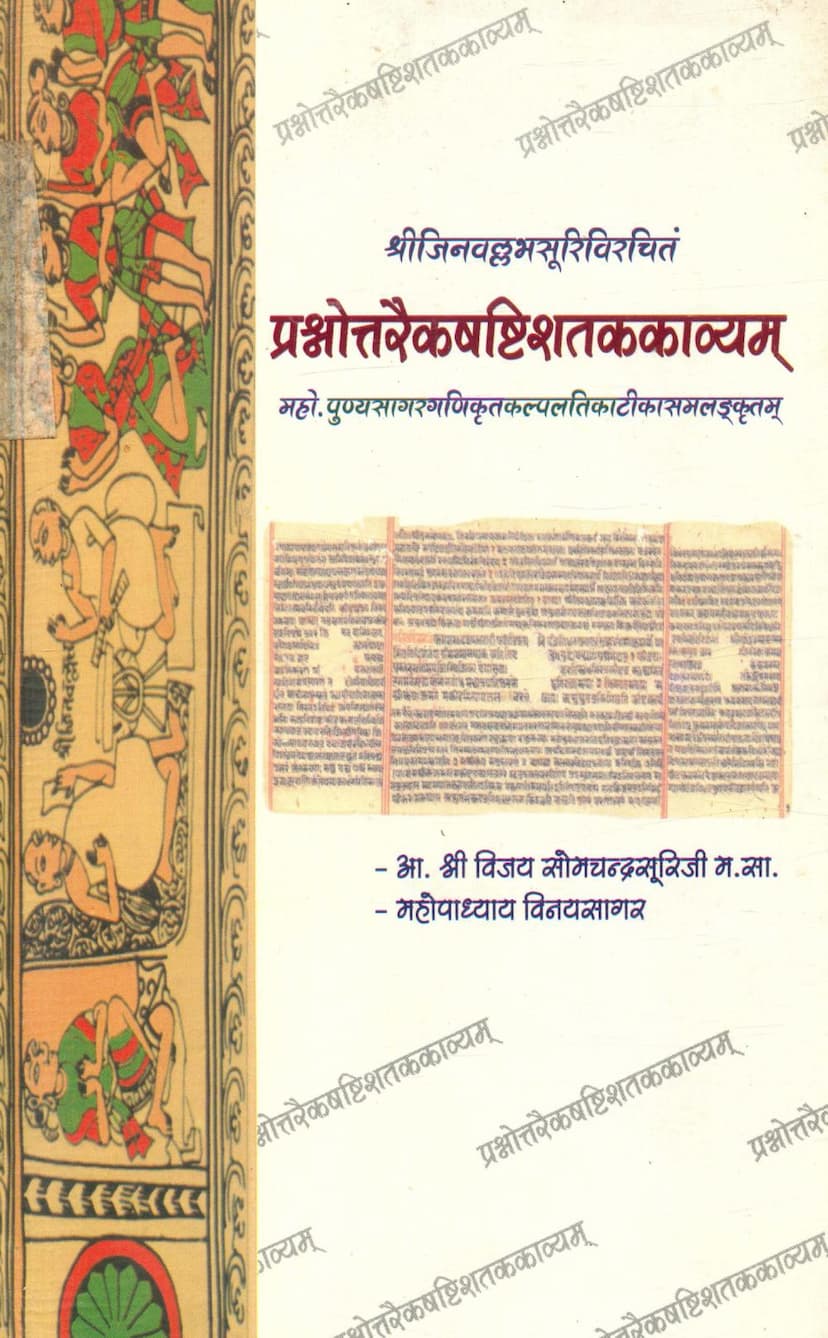Prashnottaraikshashti Shatkkavyam
Added to library: September 2, 2025

Summary
This document is a digitized version of the Jain text "Prashnottaraikshashti Shatkkavyam" (प्रश्नोत्तरैकषष्टिशतककाव्यम्), authored by Jinvallabhsuri (श्रीजिनवल्लभसूरि), with a commentary called "Kalpalatika" (कल्पलतिका) by Somchandrasuri (सोमचन्द्रसूरि) and edited by Vinaysagar (विनयसागर). The publisher is the Rander Road Jain Sangh (श्री रांदेर रोड जैन संघ).
Here's a comprehensive summary of the provided pages, focusing on the content and context:
Overall Purpose:
The text is a collection of "Prashnottara" (प्रश्न-उत्तर), meaning questions and answers, presented in the form of poetry. The core of the work is the "Prashnottaraikshashti Shatkkavyam" by Acharya Jinvallabhsuri, which comprises 161 verses. The commentary "Kalpalatika" by Mahopadhyay Punyasagarji provides explanations and elaborations on each verse. The work is a significant contribution to Jain literature, particularly in the realm of chitra-kavya (चित्र काव्य) or patterned poetry, which involves intricate wordplay and structural arrangements.
Key Individuals and Organizations:
- Acharya Jinvallabhsuri (श्रीजिनवल्लभसूरि): The primary author of the "Prashnottaraikshashti Shatkkavyam." He was a prominent scholar and poet of the Kharatara Gaccha, known for his extensive literary output across various subjects. His life and works are detailed, highlighting his mastery of grammar, poetry, philosophy, and other disciplines.
- Mahopadhyay Punyasagarji (महोपाध्याय पुण्यसागरजी): The commentator who wrote the "Kalpalatika" on Jinvallabhsuri's work. He was also a distinguished scholar and a disciple of Jinahansuri. The introduction provides a detailed biography of Punyasagarji, listing his numerous literary contributions.
- Acharya Vinaysagar (महोपाध्याय विनयसागर): The editor of this particular publication, responsible for bringing this work to light and presenting it with scholarly apparatus. He is credited with extensive research and compilation.
- Rander Road Jain Sangh, Surat (श्री रांदेर रोड जैन संघ, सूरत): The publisher of the book, demonstrating their commitment to preserving and disseminating Jain scriptures.
- Shri Vileparle Shvetamber Mool Poojak Jain Sangh & Charities (श्री विलेपार्ले श्वे.मू.पू. जैन संघ एन्ड चेरीटीझ): Provided financial support for the publication.
- M.S.P.S.G. Charitable Trust, Jaipur (एम.एस.पी.एस.जी. चेरीटेबल ट्रस्ट, जयपुर): Also provided support and acted as a distributor.
- Various Acharyas of the Nemivigyan Kastur lineage: The publication is dedicated to and supported by the lineage of Acharyas including Shri Nemisuriji, Shri Vigyan Surisuriji, Shri Kastursuriji, Shri Vijaya Chandrodayasuriji, and Shri Vijaya Ashokchandrasuriji.
Content of the Text (Prashnottaraikshashti Shatkkavyam and Kalpalatika):
The "Prashnottaraikshashti Shatkkavyam" is characterized by its question-and-answer format within each verse. Each verse typically poses a question, and the answer is embedded within the same verse, often through wordplay, anagrams, or clever phrasing. This requires significant intellectual engagement from the reader to decipher the meaning.
The Kalpalatika commentary plays a crucial role in explaining the intricacies of Jinvallabhsuri's verses. It clarifies:
- The literal meaning: Explaining the words and their grammatical structures.
- The underlying philosophy: Connecting the verses to Jain principles and teachings.
- The chitra-bandha (चित्र बन्ध) techniques: The commentary elucidates the complex poetic structures used, such as vyasta-samasta (व्यस्त-समस्त), gata-agata (गतागत), matrka-bandha (मातृका बन्ध), and various other forms of patterned poetry. The text highlights that Jinvallabhsuri masterfully employed 46 different chitra-alakara (चित्र अलङ्कार) patterns and 33 wordplay-based patterns in the answers.
Key Themes and Characteristics:
- Intellectual Prowess: The verses are designed to be challenging riddles, demanding keen intellect and knowledge of grammar, lexicography, and Jain philosophy to solve.
- Literary Artistry: The work is a testament to the sophisticated literary traditions of ancient India, showcasing Jinvallabhsuri's exceptional command over Sanskrit and Prakrit languages and his skill in chitra-kavya.
- Spiritual Guidance: While intellectually stimulating, the verses also subtly convey spiritual messages, guiding the reader towards understanding karmic principles and the path to liberation. The editor's aspiration is for readers to find solutions to their karmic dilemmas through the study of this text.
- Historical Context: The detailed "Prakathanam" (प्राक्कथन) and "Parichay" (परिचय) sections provide valuable historical context about Jinvallabhsuri, his spiritual lineage, and the literary environment of 12th-century India. It places him among other great scholars of his time.
- Commentarial Tradition: The importance of the Kalpalatika commentary is emphasized, as it makes the abstruse verses accessible. The dedication to scholarly work in identifying, transcribing, and editing the text is also highlighted.
Structure of the Publication:
The initial pages include:
- Title page with author and commentator information.
- Acknowledgments and dedications to various Acharyas and supporting organizations.
- Editorial notes (Sampadakeey - सम्पादकीय / Prakashakeey - प्रकाशकीय) explaining the significance of the work and the publication process.
- A detailed biographical introduction ("Prachayanam" - प्राक्कथन / "Parichay" - परिचय) to Acharya Jinvallabhsuri, including his literary works and lineage.
- A biography of Mahopadhyay Punyasagarji, the commentator.
- The main text, comprising Jinvallabhsuri's verses and Punyasagarji's commentary.
- Appendices (Parishisht - परिशिष्ट) providing indexes of verses, poetic forms, and cited sources.
In Essence:
"Prashnottaraikshashti Shatkkavyam" is a scholarly and artistic masterpiece of Jain literature. It serves as a rigorous intellectual exercise and a profound spiritual guide, demonstrating the mastery of its author, Acharya Jinvallabhsuri, and the dedicated scholarship of its commentator, Mahopadhyay Punyasagarji, and editor, Acharya Vinaysagar. The publication itself represents a collaborative effort by Jain institutions to preserve and make accessible this rich literary heritage.